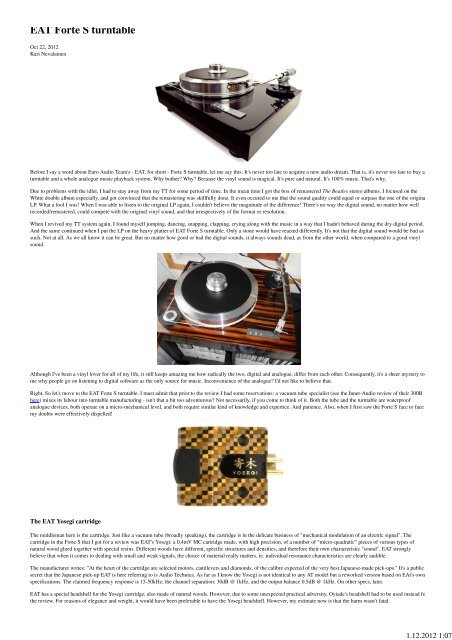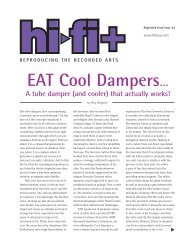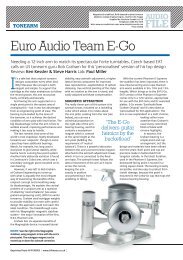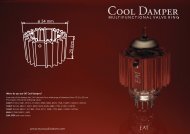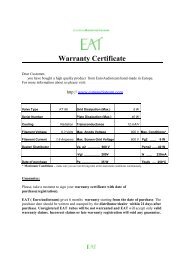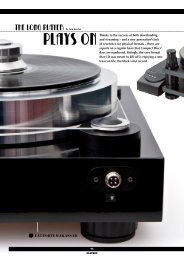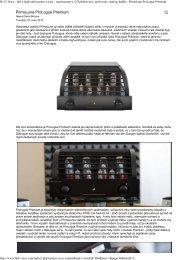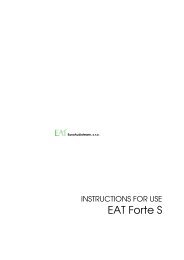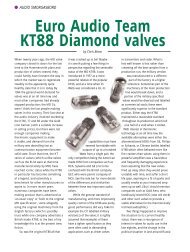Innerworld Audio - EAT Forte S turntable - EuroAudioTeam.com
Innerworld Audio - EAT Forte S turntable - EuroAudioTeam.com
Innerworld Audio - EAT Forte S turntable - EuroAudioTeam.com
You also want an ePaper? Increase the reach of your titles
YUMPU automatically turns print PDFs into web optimized ePapers that Google loves.
<strong>EAT</strong> <strong>Forte</strong> S <strong>turntable</strong><br />
Oct 22, 2012<br />
Kari Nevalainen<br />
Before I say a word about Euro <strong>Audio</strong> Team's - <strong>EAT</strong>, for short - <strong>Forte</strong> S <strong>turntable</strong>, let me say this: It's never too late to acquire a new audio dream. That is, it's never too late to buy a<br />
<strong>turntable</strong> and a whole analogue music playback system. Why bother? Why? Because the vinyl sound is magical. It's pure and natural. It's 100% music. That's why.<br />
Due to problems with the idler, I had to stay away from my TT for some period of time. In the mean time I got the box of remastered The Beatles stereo albums. I focused on the<br />
White double album especially, and got convinced that the remastering was skillfully done. It even occured to me that the sound quality could equal or surpass the one of the original<br />
LP. What a fool I was! When I was able to listen to the original LP again, I couldn't believe the magnitude of the difference! There's no way the digital sound, no matter how well<br />
recorded/remastered, could <strong>com</strong>pete with the original vinyl sound, and that irrespectively of the format or resolution.<br />
When I revived my TT system again, I found myself jumping, dancing, snapping, clapping, crying along with the music in a way that I hadn't behaved during the dry digital period.<br />
And the same continued when I put the LP on the heavy platter of <strong>EAT</strong> <strong>Forte</strong> S <strong>turntable</strong>. Only a stone would have reacted differently. It's not that the digital sound would be bad as<br />
such. Not at all. As we all know it can be great. But no matter how good or bad the digital sounds, it always sounds dead, as from the other world, when <strong>com</strong>pared to a good vinyl<br />
sound.<br />
Although I've been a vinyl lover for all of my life, it still keeps amazing me how radically the two, digital and analogue, differ from each other. Consequently, it's a sheer mystery to<br />
me why people go on listening to digital software as the only source for music. Inconvenience of the analogue? I'd not like to believe that.<br />
Right. So let's move to the <strong>EAT</strong> <strong>Forte</strong> S <strong>turntable</strong>. I must admit that prior to the review I had some reservations: a vacuum tube specialist (see the Inner-<strong>Audio</strong> review of their 300B<br />
here) mixes its labour into <strong>turntable</strong> manufacturing - isn't that a bit too adventurous? Not necessarily, if you <strong>com</strong>e to think of it. Both the tube and the <strong>turntable</strong> are waterproof<br />
analogue devices, both operate on a micro-mechanical level, and both require similar kind of knowledge and expertice. And patience. Also, when I first saw the <strong>Forte</strong> S face to face<br />
my doubts were effectively dispelled!<br />
The <strong>EAT</strong> Yosegi cartridge<br />
The middleman here is the cartridge. Just like a vacuum tube (broadly speaking), the cartridge is in the delicate business of "mechanical modulation of an electric signal". The<br />
cartridge in the <strong>Forte</strong> S that I got for a review was <strong>EAT</strong>'s Yosegi: a 0,4mV MC cartridge made, with high precision, of a number of “micro-quadratic” pieces of various types of<br />
natural wood glued together with special resins. Different woods have different, specific structures and densities, and therefore their own characteristic "sound". <strong>EAT</strong> strongly<br />
believe that when it <strong>com</strong>es to dealing with small and weak signals, the choice of material really matters, ie. individual resonance characteristics are clearly audible.<br />
The manufacturer writes: "At the heart of the cartridge are selected motors, cantilevers and diamonds, of the calibre expected of the very best Japanese-made pick-ups." It's a public<br />
secret that the Japanese pick-up <strong>EAT</strong> is here referring to is <strong>Audio</strong> Technica. As far as I know the Yosegi is not identical to any AT model but a reworked version based on EAt's own<br />
specifications. The claimed frequency response is 15-50kHz; the channel separation: 30dB @ 1kHz, and the output balance 0.5dB @ 1kHz. On other specs, later.<br />
<strong>EAT</strong> has a special headshell for the Yosegi cartridge, also made of natural woods. However, due to some unexpected practical adversity, Oyiade's headshell had to be used instead for<br />
the review. For reasons of elegance and weight, it would have been preferable to have the Yosegi headshell. However, my estimate now is that the harm wasn't fatal.<br />
1.12.2012 1:07
The <strong>EAT</strong>-312 tonearm<br />
So now <strong>EAT</strong> would need a matching tonearm. By today <strong>EAT</strong> has three tonearms, none of which it has developed from the sratch. There's the new flat tonearm for the new <strong>EAT</strong> Flat<br />
<strong>turntable</strong>. The tonearm that standardly goes with the <strong>Forte</strong> S and its tonearm base is <strong>EAT</strong> modified Project 12" carbon tonearm. The tonearm installed in the review individual was<br />
<strong>EAT</strong>-312, apparently replacing their earlier Ikeda-based IT 407. Installing it requires an adapter but <strong>EAT</strong> provides adapters for various tonearms, also other than its own.<br />
The <strong>EAT</strong>-312 is a 12", heavy aluminium tube tonearm with a low resonance and SME-type cartridge connection. The arm is said to be based on old Ortofon Studio tonearm. It looks<br />
like the vintage Ortofon RMA/RMG-309. It's different from Ortofon's modern "classic" tonearms: AS-309S or RS-309D. The new TA-210, although static, <strong>com</strong>es closer.<br />
The <strong>EAT</strong>-312 features a ball bearing, dynamic stylus pressure spring, a huge counterweight (allowing 0-7g tracking force), adjustable height, a standard 5-pin DIN connector and the<br />
wire from the bottom of the tonearm base. The effective mass is 5g without the shell, the effective length 329mm. The total weight is around half a kilogram!<br />
The <strong>EAT</strong>-312 has no anti-skating adjustment, or rather, preadjusted anti-skating is in-built. That's sufficient for majority of cartridges that go with it, such as heavy Ortofon SPUs but<br />
also for somewhat lighter carts. When the tracking force is beyond 2,5 grams, it's arguable that anti-skating looses its importance.<br />
But <strong>com</strong>pliance is an issue. Normally such heavy classic tonearms prefer low <strong>com</strong>pliance cartridges. The static <strong>com</strong>pliance of the <strong>EAT</strong> Yosegi cart is 35×10-6cm/dyne; and the<br />
dynamic <strong>com</strong>pliance 18×10-6cm/dyne (100Hz). Staring at those figures only the Yosegi may not seem the optimal match with the <strong>EAT</strong>-312 but not an entirely impossible choise<br />
either. At any rate, the way it sounded didn't give any signs of incongruence.<br />
It should be noted that the <strong>EAT</strong>-312 and its counterweight are meant for heavy cartridges between 20-30 grams. The 6g Yosegi requires extra weight between it and the headshell, at<br />
least if other than its own headshell is used.<br />
All in all, for me personally the <strong>EAT</strong>-312 is a wonderful tonearm in many respects, and particularly for friends of Denon DL-103, Ortofon SPU's or EMT cartridges (the latter are<br />
nowadays are available for SME connection without the EMT shell).<br />
<strong>EAT</strong> <strong>Forte</strong> S<br />
1.12.2012 1:07
<strong>EAT</strong> <strong>Forte</strong> S<br />
Now we need a <strong>turntable</strong>. <strong>EAT</strong> has three of them: the mentioned E-Flat, the flagship <strong>Forte</strong>, and its "reduced" version: the <strong>Forte</strong> S. "Reduced" because the platter diametre is 36cm<br />
instead of 40cm. But note: 36cm is still 6 cm wider than that of a standard 30cm platter, and its moving mass is much higher than the moving mass of a standard platter. <strong>EAT</strong><br />
believes that the "effectiveness of the sound" is geometrically related to the size of the diametre of the platter: double it and the sound gets four times more effective. I don't know<br />
exactly what they mean by "effectiveness of the sound" but having heard the <strong>Forte</strong> S now I'm sure it points to a meaningful property of the sound. What's obvious is that playing<br />
with <strong>Forte</strong> S makes one feel like playing with the mighty EMT 927 - or other professional TTs from the golden radio era.<br />
The 15kg platter is damped with sorbothane from the inner side. A black damping matt made of recycled vinyl damps from the outer side. The purpose of the construction is to make<br />
the platter <strong>com</strong>pletely quiet. Sorbothane is also used to damp the bearing housing, tonearm base and the magnetic feet.<br />
Just like other <strong>EAT</strong> <strong>turntable</strong>s, the <strong>Forte</strong> S is mass-loaded with huge height-adjustable magnetic feet acting as a sub chassis. Thanks to the feet system, the resonance frequency of<br />
the entire system is dumped down to a very low level making the need for a special <strong>turntable</strong> stand less urgent.<br />
As to the bearing, <strong>EAT</strong> <strong>Forte</strong> S emplois an inverted construction in which the platter (the Teflon cup) rests on a ceramic ball on the top of a pin. In order to reduce the pressure on the<br />
ceramic ball from be<strong>com</strong>ing too heavy, two enormous neodymium magnets hold the platter 'in the air'.<br />
The <strong>Forte</strong> S sports two AC motors but unlike in the bigger <strong>Forte</strong>, the motors are not in a separate chassis. Instead they are in the same single-piece plinth and placed symmetrically<br />
on the left side of the platter. The only beauty spot of the whole construction is the outboard power supply (16V/1.000mA AC), which I'm sure is technically adequate for the pupose<br />
(the power consumption is only 4W) but looks like one stolen from some gadget. For a <strong>turntable</strong> of this calibre matters of appearance also matter.<br />
Otherwise the <strong>Forte</strong> S looks absolutely gorgeous. The 55cm width and 44kg mass gives a certain irresistable authority to it, ownership pride too. The luxurous Makassar finishing is<br />
not my personal favourite in <strong>turntable</strong>s but black gloss and Zebrano finishes are also available.<br />
I couldn't measure the <strong>Forte</strong> S but all the published measurements I've seen point to the fact that the construction of the <strong>turntable</strong> is technically of the highest class.<br />
Putting the three together<br />
The Yosegi outputs 0,4mV. That is more than many other highend MC's, but not as high as to make it a high-output MC. The max. 40dB gain provided by my Sentec EQ11<br />
RIAA/MONO phonostage wasn't quite enough for the Yosegi so I needed a MC step-up. I tried more than one, the ideal input impedance being around 100 ohms.<br />
From the Sentec EQ11 the signal went through Gregitek interconnects to the modified Dynakit tube preamp, Behringer DCX-9624, to 6V6PP & 6L6G SE poweramps, and AGA<br />
Baltic/Lansing horn speakers.<br />
To operate the <strong>Forte</strong> S was obvious and fun: just three easily approachable small buttons: 33.3, 45.11 and ON/OFF. The only practical inconvenience <strong>com</strong>es from the fact that the<br />
<strong>Forte</strong> S, although 15cm narrower than its big brother, is still 55cm wide. The big boy needs a big bed.<br />
Sound consistency<br />
1.12.2012 1:07
Sound consistency<br />
To start with I tried a good number of piano LPs to hear if I could detect any - just any - wow from the <strong>Forte</strong> S <strong>com</strong>bo. With piano music any wow would be irritating indeed, if<br />
present. But no wow whatsoever. The test passed. And general speaking, the <strong>Forte</strong> S <strong>com</strong>bo did not have an erroneous kind of sound but its opposite. No flutter either, althoug I<br />
think flutter is less of a risk with this type of <strong>turntable</strong> construction.<br />
The speed variance of <strong>EAT</strong> <strong>Forte</strong> S is, according to the manufacturer, +/- 0,09%. But it's not just that technical speed stability that matters. When my daughter practices cello, I often<br />
ask her, before she adds any slow/fast variations of her own, to play the piece first as if she were a metronome, like a bulldozer, keeping timing and tempo razor sharp, instead of<br />
"quite correct". It is quintessential for musical satisfaction that a turtable behaves like a bulldozer, rushing through the piece respecting the fundamental temporal progression at the<br />
bottom of the <strong>com</strong>position. This I guess is one of the major reasons why idler-driven TTs are so liked in some corners, and I very, very much liked what the <strong>Forte</strong> S was able to do in<br />
this regard.<br />
Yet another thing. Have you noticed how fast the actual tempo often is in pop and rock songs (take the Beatles, for example), even in the slower ones? The fact is easy to confirm by<br />
trying to play the same song by oneself at the original tempo; time and again I'm amazed by the chosen tempo on the recording, and how fast it is as <strong>com</strong>pared to the perceived one,<br />
just like hymn singing church-goers lag behind the tempo suggested by the cantor. The better TT, the more directly it conveyes the actual, fast tempo of the songs. The <strong>Forte</strong> S is<br />
such a <strong>turntable</strong>.<br />
As to softness/coldness of the tone, which I associate mainly with the qualities of the cartridge, the <strong>Forte</strong> S/Yosegi <strong>com</strong>bo delivered quite a nice package of mellowness/roundness<br />
on one hand, and sharper accuracy/resolution on the other. Yosegi ain't Ortofon SPU or EMT TDS-15 (not even with van den Hul stylus profile), it ain't like the Benz precision<br />
instruments either. It's somewhere in the middle, featuring a little bit of the best of the two worlds. That suited to my personal likings perfectly, but that's only me.<br />
As to definition/timbre, let me just say this. No one should <strong>com</strong>e and tell how a guitar ought to sound, or a violin or a clarinet or any other instrument ought to sound before he or<br />
she has heard how the instrument in question sounds on the original LP through a quality <strong>turntable</strong> system. And I'm not at all talking about the "true color" of the tone estimated by<br />
some vague reference to some long gone concert event; I'm talking about how the sound feels. With a well-made <strong>turntable</strong> it feels - it felt - so good and right. I doubt it can never feel<br />
the same in the digital domain.<br />
The bass department was also surprisingly good although I know <strong>turntable</strong>/tonearm/cartridge <strong>com</strong>binations that can dig the bass out of the groove equally convincingly. Here my<br />
verdict is that to the extent the bass quality depends on the <strong>turntable</strong> itself, there's no need to worry.<br />
However, I want to stress again and again that properties related to the quality of the bass, treble, mid-range, sound-stage etc. are always of minor importance as <strong>com</strong>pared to what<br />
the <strong>turntable</strong> can do or cannot do with matters relating to music's temporal progression. And in this regard this <strong>EAT</strong> <strong>com</strong>bination including the <strong>EAT</strong> <strong>Forte</strong> S <strong>turntable</strong> & <strong>EAT</strong> Yosegi<br />
cartridge & <strong>EAT</strong>-312 tonearm is really, really a <strong>com</strong>petent one, smooth and still vivid sounding, such a joy to the ear. Sonically the <strong>EAT</strong> <strong>Forte</strong> S reminded me of superb sounding<br />
Verdier <strong>turntable</strong>s, which to those who know Verdier <strong>turntable</strong>s, tells a lot.<br />
In conclusion<br />
The <strong>EAT</strong> <strong>Forte</strong> S together with the <strong>EAT</strong>-312 tonearm and Yosegi cartridge cost about eight nine thousand euros. It's not within possibilities of most us but still, I'd say, <strong>com</strong>petitive.<br />
It's a <strong>com</strong>bination for the rest of one's life. The <strong>turntable</strong> itself is of so high quality, technically and sonically, that I'd stop looking for a better. No doubt there's a whole bunch of<br />
"better" and pricier <strong>turntable</strong>s on the market, but I'd rather put my energy and efforts in finding a tonearm/cartridge <strong>com</strong>bination that maximally <strong>com</strong>pliments both the <strong>Forte</strong> S and<br />
the taste. My taste was well served with the <strong>EAT</strong>-312 tonearm. It's a tempting choice also because it enables having five or six different cartridges, including mono ones, fixed in<br />
their own headshell, and then changing the cartridge according to music genre, recording, time of the day, the weather, and so forth.<br />
The major difference between the <strong>EAT</strong> <strong>Forte</strong> S <strong>com</strong>bo and lesser <strong>turntable</strong>s is that with the former it be<strong>com</strong>es so obvious that the digital sound can never be equally touching and<br />
real as the vinyl sound. No same charm, no same magic.<br />
<strong>EAT</strong> <strong>Forte</strong> S, Makassar without tonearm 5.070 EUR; <strong>EAT</strong> <strong>Forte</strong> S, Piano Black without tonearm 4.470 EUR; <strong>EAT</strong> <strong>Forte</strong> S, Makassar with ProJect 12" cc EVO 5.970 EUR; <strong>EAT</strong><br />
<strong>Forte</strong> S, Piano Black with ProJect 12" cc EVO 5.370 EUR; <strong>EAT</strong> Yosegi cartrdige, 1.550 EUR; <strong>EAT</strong> Yosegi headshell 555 EUR; <strong>EAT</strong> 312 12" tonearm 2.490 EUR; <strong>EAT</strong> <strong>Forte</strong> S<br />
Acrylic Dust Cover 495 EUR.<br />
www.stereohelsinki.fi<br />
www.euroaudioteam.<strong>com</strong><br />
www.scanteknik.fi<br />
<strong>EAT</strong> Yosegi Specifications:<br />
Cartridge type: Moving-coil<br />
Frequency response: 15-50kHz<br />
1.12.2012 1:07
Output voltage: 0.4mV @ 1kHz, 5cm/sec<br />
Channel separation: 30dB @ 1kHz<br />
Output balance: 0.5dB @ 1kHz<br />
Vertical tracking force: 1.8-2.2g<br />
Coil impedance: 12Ω (1kHz)<br />
DC-resistance: 12Ω<br />
Coil inductance: 26µH (1kHz)<br />
Static <strong>com</strong>pliance: 35×10-6cm/dyne<br />
Dynamic <strong>com</strong>pliance: 18×10-6cm/dyne (100Hz)<br />
Vertical tracking angle: 23°<br />
Weight: 6g<br />
<strong>EAT</strong> <strong>Forte</strong> S Specifications:<br />
Electronic speed change * 33.33/* 45.11<br />
Speed variance ±0.09%<br />
Wow and flutter ±0.009%<br />
Signal-to-noise ratio -73dB<br />
Power consumption 4W<br />
Outboard power supply 16V/1.000mA AC, suitable for your country's mains supply<br />
Dimensions (WxHxD) 550x250x450mm<br />
Weight 44kg<br />
1.12.2012 1:07


